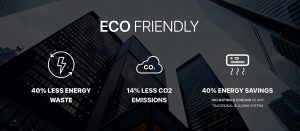Written by Zeina Kalthoum
Reading time: 5 minutes
Energy and buildings
Buildings consume large amounts of energy and also contribute substantially to greenhouse emissions. The building sector in Europe accounts for 40% of final energy consumption and is responsible for around 36% of CO2 emissions. Moreover, the 62% of final energy consumed by buildings corresponds to households being the dominant energy enduse (around 70%) of space-heating.
Considering that the 75% of the total building stock in Europe are residential buildings and, according to the housing statistics recently published by the European Commission , in 2011 the 58% of the European citizens were living in different types of single-family houses (detached, semi-detached and terraced houses), this type of buildings are the most relevant energy consumers and CO2 emitters.
These studies also predict that the housebuilding activity in Europe should rise steadily over the next few years in order to solve the housing shortage (especially social housing) in many EU countries. This scenario requires improving the eco-efficiency of the building industry and the energy performance of Europe’s residential building stock not only to achieve the targets of the European Union but also to meet the longer term objectives of its climate strategy as laid down in the low carbon economy roadmap 2050. One of the most promising approaches to reaching these goals is related to the building’s design. Particularly, those related with the choice of appropriate wall and roof solutions for each location .
At the same time, the improvement of the bearing capacity of structural materials, the advance in new construction technologies and the development of structural analysis methods and tools, allows the nowadays architects and building engineers to design buildings that achieve the best structural performance by means of structural systems (frames, trusses, grids) based on linear elements, efficiently arranged and joined, and highly specialized for transferring loads (gravitational, wind, earthquake) to the ground. Unfortunately, such kind of building’s structure solutions are mechanically efficient but devote a significant amount of resources to solve only the building’s load transfer requirements.
The society will have more available energy for using the buildings if less energy is trapped into the building’s materials or consumed during the construction process. the technical solutions designed for the structure (MSP, RCF and SF), foundation, roof and wall characteristics (internal and external) being the thermal envelope designed to achieve thermal insulations well above the requirements fixed by the Building Regulations.
In the following sections results about embodied energy, CO2 emissions and economic cost, considering the type of building and its structural system, are shown. The calculated amounts and percentages refer only to the building components specified for each configuration: foundations, structure, envelope external walls and roof and internal walls. It was assumed that additional building components like: flooring, plaster, painting, carpentry, windows, plumbing, heating, and electricity systems, etc.

The Future of Building Systems
An example of an efficient and sustainable building material is Xpanel Building Technologies. A set of precise tools as a one-stop construction solution for the building industry based on three-dimensional composite concrete structures. This system provides cost and time savings, at the same time delivering high structure resistance and thermo-acoustic insulation.
Composite structural panels of the Xpanel Building Technologies are formed by a high resistance steel 3D structure, expanded polystyrene, and high-strength concrete.
What is the X-panel system ?
-
Technical Specifications
Xpanel Building Technologies is based on a group of EPS panels with welded wire fabric on each side consisting of highly strength steel wires attached to one another by diagonal electrically welded steel connectors oriented in 4 directions, providing similar mechanical properties in both directions, acting as a two-way element. These Xpanels are installed on site in accordance with the layout of walls, partitions and slabs as per architectural project and concreted on site by means of the use of plastering machines or through concrete formwork systems. The Xpanels are produced on the fully automatic welding line which assembles the 3 components: steel welded mesh, diagonal steel connectors wires and insulation core.
-
General Cross Section
The number of diagonal wires per square meter can be determined on the basis of the shear strength required. In general, the diagonal wire diameters is 4.0 mm and the number of diagonal wires are per m². The standard widths of the panels elements is mm and their lengths are variable depending on the project requirements and designed accordingly. For the 3D construction method, the EPS insulation core fulfills several important functions. On the one hand, it serves as shuttering for applying the concrete layers, on the other hand it also acts as a displacement body in the sandwich construction method of the system. Moreover, it reduces the concrete requirement to a statically and constructionally warrantable minimum. Last but not least, the EPS core also contributes its share to the excellent heat insulation properties of the constructions.
-
3D View Panel
The Xpanel receives its strength and rigidity from the two-way steel connectors wires diagonal welded to the welded wire fabric on each side. This produces truss behavior which is highly rigid and provides adequate shear transfer for composite behavior in two ways. The diagonal steel connectors wires, as well as the wire used in the manufacture of welded wire fabric, are made of high tensile steel of 4 mm diameter creating a welded fabric wire of mm. The insulation core is expanded polystyrene (EPS) auto extinguishable and having a low density (approx kg/m³). The panels are manufactured in EPS thicknesses varying from 30 to 200 and concrete thickness can vary from 40 to 60 mm. The X-panel construction technologies have been approved by BTSI and recently by the National housing company. The system offers quality, time saving and meets all sustainability requirements.

Content Creator Sustainable Architecture
“Zeina is passionate, ambitious, and empathetic architect with a focus on sustainability and renewable energy, Zeina Kalthoum believes that our main purpose as architects is to make a dignified life by finding solutions for urban communitiy problems. Also strengthening society with research and case studies combined with modern-design thinking. Zeina currently works as a Junior Architect for B8 Architecture, a renowned International Award-Winning Architectural & Design Studio. Based in Dubai, Marbella and Madrid.”
References:
www.elsevier.com/locate/enbuild
xpaneltechnologies.com
https://docplayer.net/227085248-Xpanel-technologies-technical-specifications.html


